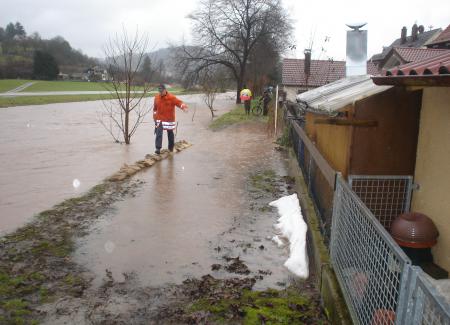FAQs
How long does it take to set up a Beaver dam?
The amount of time it takes to set up one of our dams depends on a numerous factors, the decisive ones being the following: the model of Beaver dam that you’re setting up; dam diameter and length; the size of the crew that’s setting up the dam; the terrain where the dam’s being set up; the time of day; the water capacity of the water source. It’s difficult not only for us, but also for other companies that make inflatable dams, to indicate how long a given dam takes to set up in general. Experience has shown, however, that, depending on the factors mentioned above, it takes 30 to 40 times less time to set up a Beaver flood preparedness system than a comparable sandbag dam. To take only one example: During stormy weather and flooding in August 2005, an eight man crew in Lucerne, Switzerland set up a 320 long model M50 Beaver inflatable dam in a mere 90 minutes.
Are Beaver flood preparedness systems watertight?
No. There’s no such thing as a 100 percent watertight emergency portable storm and flood preparedness solution. The internationally accepted leakage rate is two to three liters per minute and running meter. However, under normal circumstances, the leakage rate of Beaver inflatable dams is far below this figure. Plus you also need to bear in mind that the leakage rate of a sandbag dam is considerably higher than the accepted two to three liter per meter and minute rate referred to above.
Can a Beaver inflatable dam tip over or float away?
Beaver flood preparedness dams exhibit a broad standing surface and provide extremely high standing stability. Our experience with the deployment of our dams in emergencies, in some cases under extreme conditions, as well as studies that have been conducted, show that our dams are extremely stable and reliable in the deployment scenarios that we’re aware of, provided that the dams are deployed and set up properly, The stability of a given inflatable dam is determined by the following factors: subsurface; water impact angle and speed; gradient (lateral and lengthwise); and whether or not the dam has been set up properly. It is in any case absolutely essential to factor in freeboard and additional water level elevation.
A dam may have a tendency to drift away under certain circumstances. This can occur, for example, along a running length of multiple meters in the presence of an unusually high cross-slope (lateral gradient). A dam may also have a considerably greater tendency to drift away if it is installed on grass stalks, cornstalks, or loose gravel. Dams that are installed on snow or ice will not exhibit the requisite stability, and will have a tendency to drift away. The tendency of an onshore Beaver dam to drift away can be reduced by placing sandbags on top of the dam. This method is also useful in cases where a third inflatable dam unit is used in an emergency.
Is it possible to reposition a Beaver inflatable dam?
A Beaver inflatable dam can be repositioned at any point along the dam, and in both directions – without the use of any special elements. This virtually unlimited adjustability for onshore Beaver inflatable dams is unique.
Can the height of a Beaver inflatable dam be increased?
Absolutely. The flood preparedness height of all of our models can be increased by around 60 percent by placing a third inflatable dam (single dam element) on top of the existing elements. Such measures, which are normally implemented in an emergency, can be extremely useful under certain circumstances. However, you need to bear in mind that placing an additional dam element on top of an existing inflatable dam can increase the tendency of the entire structure to tip over or float away. In any such case, it is absolutely essential that the measured water level not exceed the flood preparedness height of the dual element. In cases where the water appears likely to overflow the dual element, placement of a third inflatable dam (single dam element) can be an extremely useful measure.
Why are two adjacent inflatable dam elements used?
The reason for this is that an individual inflatable dam element would roll away, due to the pressure exerted by the water, or in the presence of a cross gradient. Attaching two adjacent inflatable dams makes it extremely unlikely that the dams will roll away. What’s more, two inflatable dams provide greater stability than use of a single inflatable dam (bladder). The use of two inflatable dam elements has no bearing upon the extent to which a dam is leakproof.
How does one go about storing Beaver inflatable dams?
In order for our dams to be stored, they need to be clean and dry inside and out, and ready for deployment – which means that all closures need to be mounted and in their closed positions. The storage facility needs to be dry, with ambient temperatures ranging from minus 30 °C to plus 70 °C. The maximum allowable stacking height of the dams ranges from 120 to 150 centimeters. The reason for this is that the weight of a higher stack would subject the dam folds to undue stress. For further information see our handling, maintenance and storage data sheet titled “Behandlung, Wartung und Einlagerung”.
Are Beaver inflatable dams 100 percent watertight?
No. There’s no such thing as a 100 percent watertight portable storm and flood preparedness solution.
Compared to sandbag dams, Beaver inflatable dams take considerably less time to set up and are far more watertight.
In point of fact, Beaver inflatable dams are nearly 100% leakproof and exhibit a leakage rate lower than two to three liters per minute and running meter.
It’s advisable to factor freeboard into the equation.





